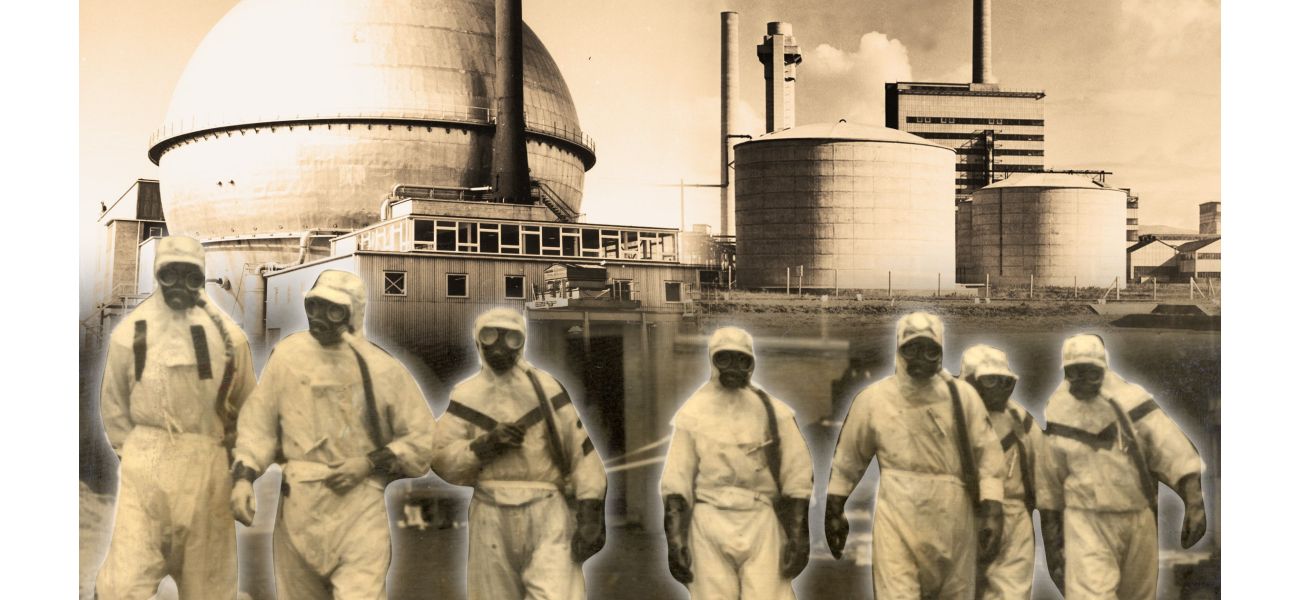A disaster in Britain almost caused the north to become a nuclear wasteland.
The crash is believed to have resulted in numerous cancer diagnoses.
October 10th 2024.

For years, the Windscale fire was considered one of the most devastating nuclear disasters in history. The thought alone of the blazing 1,300°C fire in front of the workers was terrifying enough, but they also knew that a single mistake could potentially turn northwest England into a desolate nuclear wasteland.
It all began on the coast of Cumbria, at the Windscale nuclear plant. For days, no one was aware that one of the two plutonium-producing reactors on site was engulfed in flames. At first, the workers assumed it was just a minor malfunction, nothing to worry about. After all, how could the uranium inside be on fire? However, as the days passed, it became clear that this was no small incident.
On October 10, 1957, the fire was discovered in reactor one, which was responsible for producing plutonium for atomic weapons and powering homes. The situation quickly turned critical as a steam explosion seemed imminent. The workers, clad in protective radiation suits, desperately tried to push the fuel rods out of the air-cooled graphite reactor. Water was barely able to contain the inferno, and it was only when the air was cut off in the reactor room that the three-day blaze finally came to an end.
But the damage had already been done. Radioactive materials, including cancer-causing iodine-131, had been released into the air and spread across the UK and Europe. Up until the Chernobyl disaster in 1986, the Windscale fire was considered one of the worst nuclear accidents in history, and it remains the worst in Britain. However, for decades, government officials went to great lengths to conceal the details of the accident, even destroying evidence that pointed to staff errors, disorganization, and inadequate safety measures.
The Windscale plant was built in the 1940s, driven by the fear and paranoia of the Cold War. The British government saw it as a crucial step in developing their nuclear weapons capability, believing that keeping up with the US was necessary for protection against Soviet aggression. As Phoebe Russell of Keele University wrote, it was also a way of proving their power and worthiness to collaborate with the Americans.
The engineers working on the plant were well aware of the government's urgency to get it up and running by 1952. For a complex nuclear reactor, that was an incredibly short deadline. But they managed to meet it, and by August of that year, enough plutonium had been produced to create a nuclear device, which was used by the country for the first time. However, in their haste, corners had been cut. Instead of the standard water-cooling system, the Windscale piles were cooled with air, a seemingly insignificant change that would prove to have dire consequences.
Scientist John Cockcroft repeatedly insisted on installing filters in the two towers to prevent radioactive air from being blown out. Eventually, the director of the Atomic Energy Research Establishment, the research authority overseeing the plant, agreed. However, the filters were placed at the top of the 360-foot chimneys, rather than the base, earning them the nickname "Cockcroft's Follies" among the engineers who saw them as unnecessary and overpriced.
But those filters would ultimately save countless lives. On October 8, an unexpected explosion occurred inside reactor one, releasing uranium into the air. The plant staff had no idea, and in an attempt to cool down the reactor, they pumped more air into it, unknowingly fueling the fire. It wasn't until a foreman noticed smoke coming from the chimney that the operators became aware of the situation.
In an interview, the facility's manager, Tom Hughes, recalled the moment when an inspection plug was removed, revealing the red-hot fuel inside the reactor.
The Windscale fire was a catastrophic event that plagued the minds of people for years to come. The mere thought of facing a blazing fire with temperatures reaching 1,300°C was enough to send shivers down the spines of the workers. They were well aware that even a small mistake could have devastating consequences, potentially turning the peaceful northwest England into a barren wasteland contaminated with nuclear radiation.
The incident took place at the Windscale nuclear plant, situated on the coast of Cumbria. It was a crucial site for the production of plutonium, a key component in atomic weapons and a source of power for homes. However, for days, no one at the plant had any inkling that one of the reactors was engulfed in flames. Initially, they believed it to be a minor malfunction that could easily be fixed. After all, how could uranium, the fuel used in the reactor, catch fire? It was simply unimaginable. The plant was located just north of Liverpool, and the workers didn't think much of it until the fateful day of October 10, 1957.
As the fire raged on in reactor one, the workers were faced with a critical situation. The fire was threatening to cause a steam explosion, which would have catastrophic consequences. The workers quickly donned their radiation suits and rushed to push the fuel rods out of the reactor. It was a race against time as the fire continued to rage on, barely contained by the water used to extinguish it. The inferno could only be brought under control once the air supply to the reactor was cut off, which took three long days. However, the damage had been done, and radioactive material, including cancer-causing iodine-131, had been released into the atmosphere, spreading across the UK and Europe.
Windscale was the first-ever full-scale atomic power station in the world, a source of pride for the British government. However, it soon became known as the site of one of the worst nuclear accidents in history, until the infamous Chernobyl disaster of April 1986. Despite this, the government went to great lengths to suppress details of the accident, even going as far as shredding papers that revealed the truth about the staff's negligence, poor organization, and inadequate safety measures.
The construction of Windscale was a result of the rising tensions between the US and Russia during the Cold War. The British government was determined to keep up with the two superpowers and believed that having nuclear weapons was essential to protect the country from Soviet aggression. The project was seen as a symbol of Britain's power and capability, and the government was eager to collaborate with the Americans in this groundbreaking venture. The engineers working on the project knew the pressure they were under, given the tight deadline of 1952. It was a monumental task to build a complex nuclear reactor in such a short time.
The construction of the power plant was a race against time, with the government's increasing paranoia due to the Cold War. However, they managed to meet the deadline, and by January of that year, the first fuel rods were inserted into the reactor. By August, enough plutonium had been produced to make a nuclear weapon, which was then used in the country's first atomic bomb. But in their haste to meet the deadline, corners were cut, and the standard water-cooling system was replaced with an air-cooling system. This seemingly small change had grave consequences as it led to radioactive air being blown out into the environment.
Fortunately, scientist John Cockcroft insisted that filters be installed in the two towers to prevent this from happening. His persistence paid off, and the filters were eventually installed. However, they were placed at the top of the 360-foot-high chimneys, much to the engineers' disdain. They saw it as a wasteful and unnecessary expense and nicknamed them "Cockcroft's Follies." Little did they know that these filters would play a crucial role in saving lives when the fire broke out on October 8.
The incident was caused by an aluminum canister bursting inside the reactor, followed by the uranium cartridges, which released the highly radioactive material into the air. The workers were unaware of this, and in an attempt to cool down the reactor, they pumped more air into it, which only fueled the flames further. It wasn't until a foreman noticed smoke coming out of the chimney that the staff realized the gravity of the situation. The fuel inside the reactor was red hot, and the fire had been burning for several days.
In an interview, the facility's manager, Tom Hughes, recalled the events of that day, when an inspection plug was removed, revealing the true extent of the disaster. The Windscale fire remains a dark chapter in British history, a stark reminder of the dangers of nuclear power and the need for strict safety measures. It serves as a testament to the bravery of the workers who risked their lives to bring the fire under control and the importance of learning from past mistakes to prevent such disasters from happening again.
It all began on the coast of Cumbria, at the Windscale nuclear plant. For days, no one was aware that one of the two plutonium-producing reactors on site was engulfed in flames. At first, the workers assumed it was just a minor malfunction, nothing to worry about. After all, how could the uranium inside be on fire? However, as the days passed, it became clear that this was no small incident.
On October 10, 1957, the fire was discovered in reactor one, which was responsible for producing plutonium for atomic weapons and powering homes. The situation quickly turned critical as a steam explosion seemed imminent. The workers, clad in protective radiation suits, desperately tried to push the fuel rods out of the air-cooled graphite reactor. Water was barely able to contain the inferno, and it was only when the air was cut off in the reactor room that the three-day blaze finally came to an end.
But the damage had already been done. Radioactive materials, including cancer-causing iodine-131, had been released into the air and spread across the UK and Europe. Up until the Chernobyl disaster in 1986, the Windscale fire was considered one of the worst nuclear accidents in history, and it remains the worst in Britain. However, for decades, government officials went to great lengths to conceal the details of the accident, even destroying evidence that pointed to staff errors, disorganization, and inadequate safety measures.
The Windscale plant was built in the 1940s, driven by the fear and paranoia of the Cold War. The British government saw it as a crucial step in developing their nuclear weapons capability, believing that keeping up with the US was necessary for protection against Soviet aggression. As Phoebe Russell of Keele University wrote, it was also a way of proving their power and worthiness to collaborate with the Americans.
The engineers working on the plant were well aware of the government's urgency to get it up and running by 1952. For a complex nuclear reactor, that was an incredibly short deadline. But they managed to meet it, and by August of that year, enough plutonium had been produced to create a nuclear device, which was used by the country for the first time. However, in their haste, corners had been cut. Instead of the standard water-cooling system, the Windscale piles were cooled with air, a seemingly insignificant change that would prove to have dire consequences.
Scientist John Cockcroft repeatedly insisted on installing filters in the two towers to prevent radioactive air from being blown out. Eventually, the director of the Atomic Energy Research Establishment, the research authority overseeing the plant, agreed. However, the filters were placed at the top of the 360-foot chimneys, rather than the base, earning them the nickname "Cockcroft's Follies" among the engineers who saw them as unnecessary and overpriced.
But those filters would ultimately save countless lives. On October 8, an unexpected explosion occurred inside reactor one, releasing uranium into the air. The plant staff had no idea, and in an attempt to cool down the reactor, they pumped more air into it, unknowingly fueling the fire. It wasn't until a foreman noticed smoke coming from the chimney that the operators became aware of the situation.
In an interview, the facility's manager, Tom Hughes, recalled the moment when an inspection plug was removed, revealing the red-hot fuel inside the reactor.
The Windscale fire was a catastrophic event that plagued the minds of people for years to come. The mere thought of facing a blazing fire with temperatures reaching 1,300°C was enough to send shivers down the spines of the workers. They were well aware that even a small mistake could have devastating consequences, potentially turning the peaceful northwest England into a barren wasteland contaminated with nuclear radiation.
The incident took place at the Windscale nuclear plant, situated on the coast of Cumbria. It was a crucial site for the production of plutonium, a key component in atomic weapons and a source of power for homes. However, for days, no one at the plant had any inkling that one of the reactors was engulfed in flames. Initially, they believed it to be a minor malfunction that could easily be fixed. After all, how could uranium, the fuel used in the reactor, catch fire? It was simply unimaginable. The plant was located just north of Liverpool, and the workers didn't think much of it until the fateful day of October 10, 1957.
As the fire raged on in reactor one, the workers were faced with a critical situation. The fire was threatening to cause a steam explosion, which would have catastrophic consequences. The workers quickly donned their radiation suits and rushed to push the fuel rods out of the reactor. It was a race against time as the fire continued to rage on, barely contained by the water used to extinguish it. The inferno could only be brought under control once the air supply to the reactor was cut off, which took three long days. However, the damage had been done, and radioactive material, including cancer-causing iodine-131, had been released into the atmosphere, spreading across the UK and Europe.
Windscale was the first-ever full-scale atomic power station in the world, a source of pride for the British government. However, it soon became known as the site of one of the worst nuclear accidents in history, until the infamous Chernobyl disaster of April 1986. Despite this, the government went to great lengths to suppress details of the accident, even going as far as shredding papers that revealed the truth about the staff's negligence, poor organization, and inadequate safety measures.
The construction of Windscale was a result of the rising tensions between the US and Russia during the Cold War. The British government was determined to keep up with the two superpowers and believed that having nuclear weapons was essential to protect the country from Soviet aggression. The project was seen as a symbol of Britain's power and capability, and the government was eager to collaborate with the Americans in this groundbreaking venture. The engineers working on the project knew the pressure they were under, given the tight deadline of 1952. It was a monumental task to build a complex nuclear reactor in such a short time.
The construction of the power plant was a race against time, with the government's increasing paranoia due to the Cold War. However, they managed to meet the deadline, and by January of that year, the first fuel rods were inserted into the reactor. By August, enough plutonium had been produced to make a nuclear weapon, which was then used in the country's first atomic bomb. But in their haste to meet the deadline, corners were cut, and the standard water-cooling system was replaced with an air-cooling system. This seemingly small change had grave consequences as it led to radioactive air being blown out into the environment.
Fortunately, scientist John Cockcroft insisted that filters be installed in the two towers to prevent this from happening. His persistence paid off, and the filters were eventually installed. However, they were placed at the top of the 360-foot-high chimneys, much to the engineers' disdain. They saw it as a wasteful and unnecessary expense and nicknamed them "Cockcroft's Follies." Little did they know that these filters would play a crucial role in saving lives when the fire broke out on October 8.
The incident was caused by an aluminum canister bursting inside the reactor, followed by the uranium cartridges, which released the highly radioactive material into the air. The workers were unaware of this, and in an attempt to cool down the reactor, they pumped more air into it, which only fueled the flames further. It wasn't until a foreman noticed smoke coming out of the chimney that the staff realized the gravity of the situation. The fuel inside the reactor was red hot, and the fire had been burning for several days.
In an interview, the facility's manager, Tom Hughes, recalled the events of that day, when an inspection plug was removed, revealing the true extent of the disaster. The Windscale fire remains a dark chapter in British history, a stark reminder of the dangers of nuclear power and the need for strict safety measures. It serves as a testament to the bravery of the workers who risked their lives to bring the fire under control and the importance of learning from past mistakes to prevent such disasters from happening again.
[This article has been trending online recently and has been generated with AI. Your feed is customized.]
[Generative AI is experimental.]
0
0
Submit Comment





